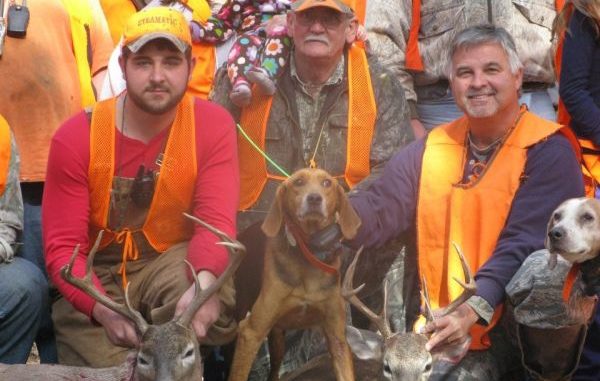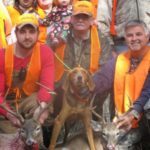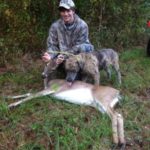
A case of the good suffering for the bad
Like many hunters throughout Louisiana and the other Southeast states, I grew up hunting deer with dogs. Members of the family kept deer hounds, and we anxiously awaited the “with or without dogs” segment of deer season.
When the date finally arrived, hunting trips took on a very different style.
Gone were the morning or evening still hunts with Dad, Granddad or Uncle, where we quietly sat watching trails or feeding areas, hoping deer would appear.
Since deer numbers were still pretty low in Central Louisiana in those days, we usually did not see much and it could get boring.
But as soon as we could start running hounds, things got more interesting — and more fun for us kids.
The trips involved all the cousins, friends and relatives we might not have seen all year. Everyone arrived at a designated meeting place at the crack of dawn.
The adults worked out the details of stand locations, and where the hounds and drivers would cast. We then dispersed to our stands, and when you were finally deemed old enough to sit a stand alone, it was a big deal and a proud moment.
So, with strict instructions to stay on the stand, we were left to wait, watch and listen.
Before long, the distant whoops of the driver could be heard as he worked the pack of hounds through the woods. With any luck the dogs would find scent they could trail to a bedded deer.
When the deer was jumped from its bed, the race was on — and so was the hound music.
If the race came your way, thoughts of being cold, wet and hungry were instantly forgotten, as your grip on your gun tightened and your eyes searched for the approaching deer.
If the deer was seen, you had a few brief seconds to determine if it was a legal buck and make the shot.
Far more often than not, the deer was antlerless or you missed.
The greatest fear was a missed shot, because you suffered the humiliation of having your shirttail cut off.
But whether the deer was killed or evaded the standers, it was over — which meant the whole process of organizing the next drive was repeated.
Those breaks between deer drives were the most fun for us kids, since we all got to meet up, have snacks and visit. Everyone had a story to tell about what they saw or heard that morning.
I can still hear the laughter and see the smiles, and those hunts went on all day.
If any deer were killed, we gathered at the end of the day at someone’s home to butcher the meat. It was divided equally among all the hunters. You might not go home with much meat, but that really was not the point.
I grew up, went to work for the Louisiana Department of Wildlife and Fisheries, and moved about 60 miles away into Avoyelles Parish. Game wardens get little time off during hunting season (remember that, all you young hunters who dream of getting the job), so those big hunts with dogs around home were over for me.
Plenty of people in my patrol area were hunting with hounds, but it was different.
Avoyelles had and still has large tracts of private land, much of it wooded or a mixture of woods and large crop fields. The deer-hound group kept to private land or hunting leases and off public land.
So they were not much of a problem for law enforcement, with the exception of occasionally killing an illegal deer.
But I was hearing news of changes in the dog-hunting landscape at home, and it was not for the better.
The large tracks of private land that we had hunted were no longer open to public hunting. The hound men I grew up hunting with were not the only ones experiencing this loss of hunting land. And the hunters leasing up this previously open land were reluctant to allow deer hounds for fear of running deer off the property.
Those circumstances pushed all the hound men (both good and bad) onto the last large land area open to public hunting with dogs: Kisatchie National Forest.
Several problems began to arise, not the least of which was brought on by progress.
KNF has a well-developed system of public roads that has been steadily increased and improved over the years. Stand lines that traditionally ran through the woods, with hunters placed on game trails and natural crossings, began to creep out to the public roads. This was a common and frequently reported violation.
Advances in technology caused more problems. As CB radios became more affordable and wildly popular, they began to be used to intercept fleeing deer at crossings, mostly on roads.
That led to using vehicles to get to the intercept points and that, in turn, led to speeding and reckless vehicle operation on those same public roads.
The advent of cell phones and texting made it even worse, as violators switched to the phones for more-covert communication. Now they were not only speeding to head off a deer but trying to dial numbers or text on the phone while doing so.
Killing illegal deer was a problem, as well. Hunters hunting on private land or leased land are usually conservative and self-policing in the harvest of wildlife, particularly deer.
But on KNF (perhaps on any public land) where deer were not that abundant to begin with, the “if I don’t kill it the next guy will” philosophy reigned.
I know of cases where enforcement agents quickly closed in on locations where shots had been heard only to find dead, illegal deer abandoned by the violators, most likely tipped off by radio or cell phone that “the man” was on the way.
But the boot that finally stomped the life out of deer hunting with dogs on KNF was trespassing on adjacent private property.
KNF is not one large, contiguous tract of public land. It is interspersed with private residential property.
Those homeowners reported people standing on the public roads in front of their homes with guns waiting for deer to appear. They reported dogs on their property, sometimes chasing or attacking chickens or other livestock.
And, worst of all, the homeowners reported belligerent and insolent behavior by those people standing on the roads and entering their private property to retrieve the dogs.
Such behavior is not acceptable to the vast majority of people, and any homeowner can relate, right down to the guy in the suburbs who gets mad when the neighbor’s dog poops in his yard.
So when those landowners complained — and complain they did — things happened.
In the final outcome, thousands of acres of public land that once had long hunting seasons and liberal regulations allowing the running and training of dogs are now listed as “still hunt only” and “the training of deer dogs is prohibited year-round.”
Hunting deer with dogs continues on private land and a few hunting leases, but not at its previous levels.
I will be the first to say that not all of the deer hound guys did the things that resulted in the loss of hunting deer with dogs on KNF and in other places. It is a classic case of the good suffering along with the bad.
The lesson to be learned is that, as hunters, we can’t tolerate bad behavior within the ranks. It is a well-known fact that the majority of people in the United States today do not hunt. But they have nothing against hunting and don’t oppose it.
So it is very important for hunters to demonstrate good, ethical behavior and eliminate illegal, unacceptable behavior from the ranks — no matter how or what they hunt.
We don’t need unwanted attention and disapproval by the majority, which can only lead to the loss of hunting opportunities.
None of us wants to see that happen.




